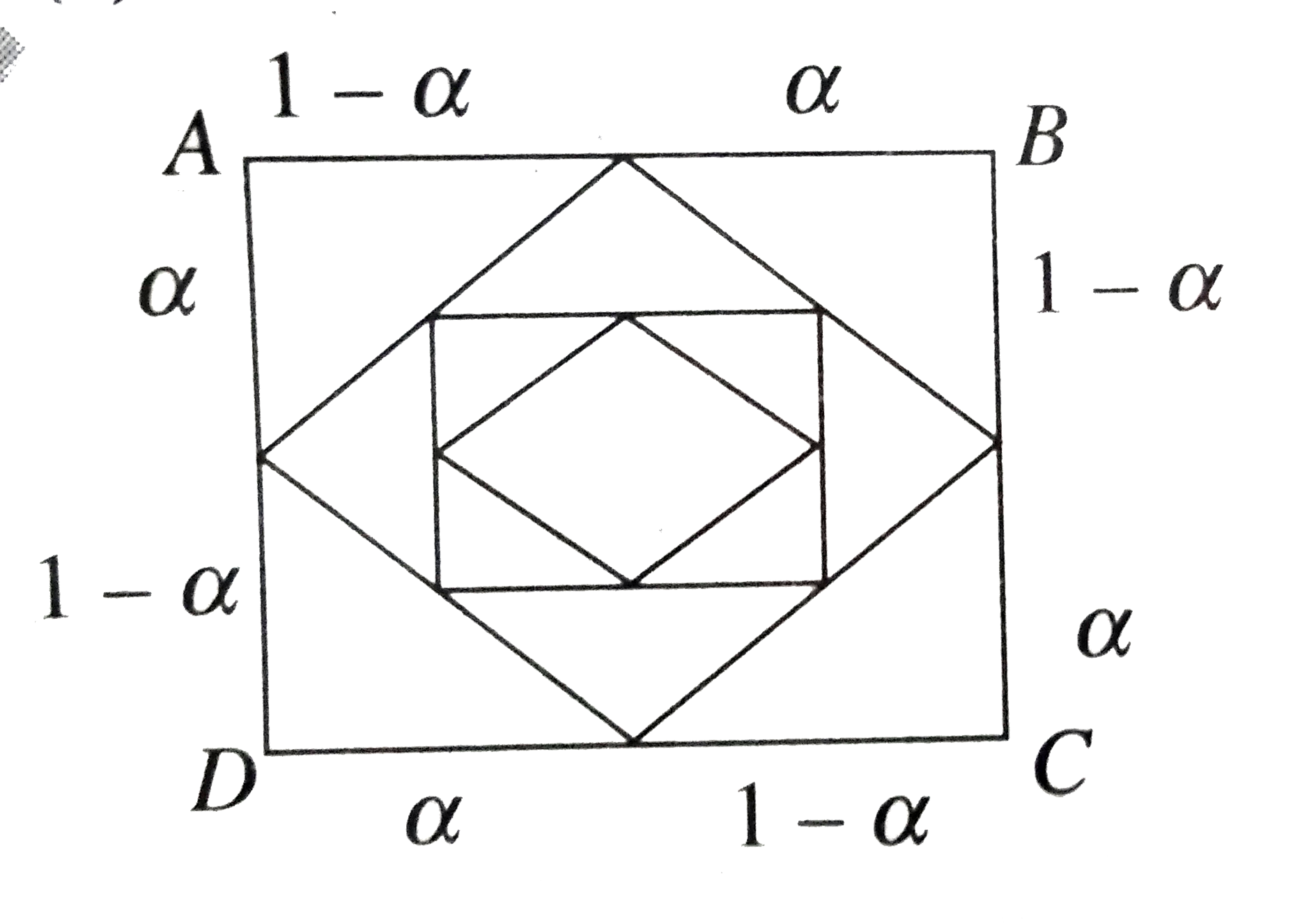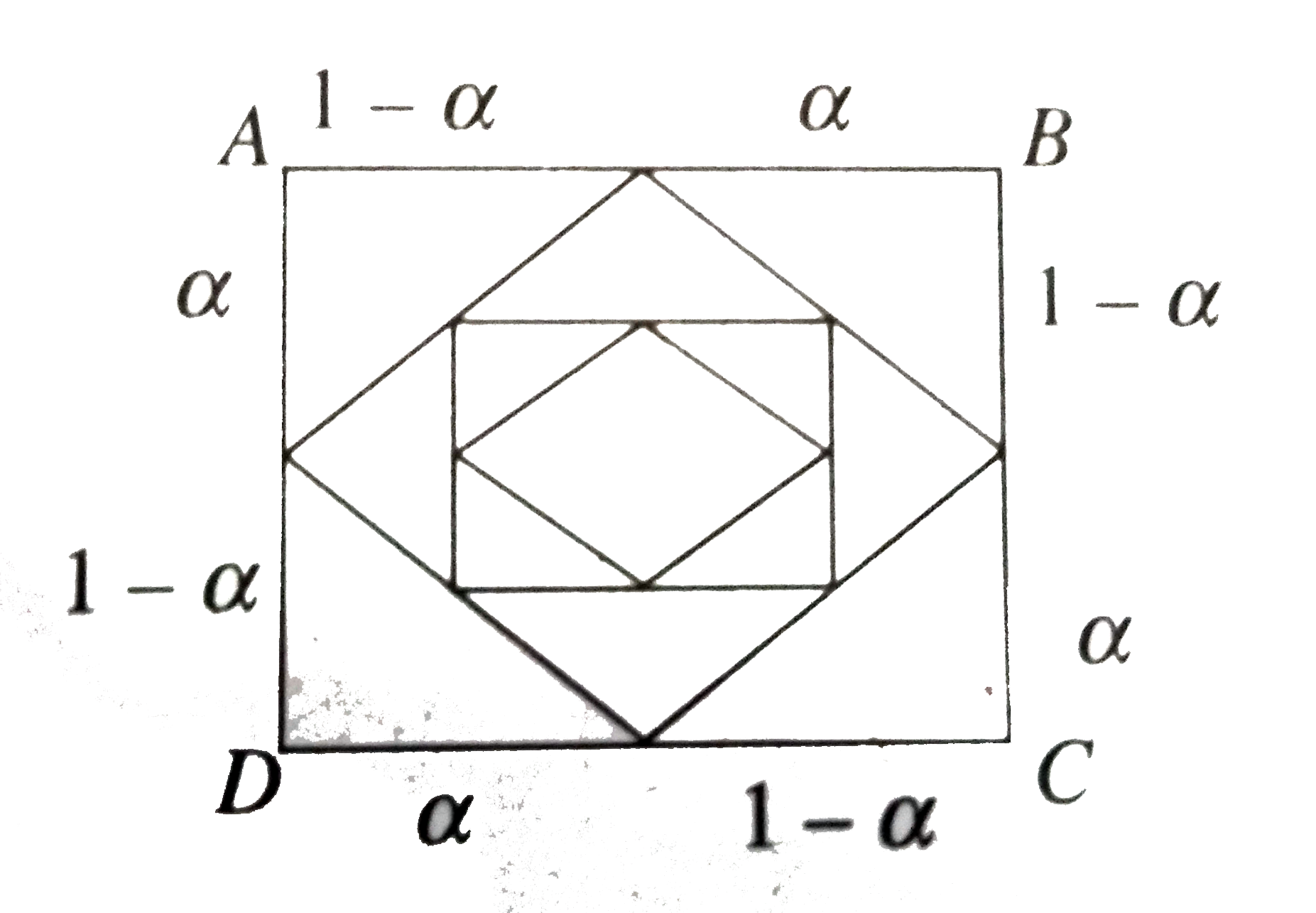
Let ABCD is a unit square and each side of the square is divided in the ratio α:(1−α)(0<α<1) . These points are connected to obtain another square. The sides of new square are divided in the ratio α:(1−α) and points are joined to obtain another square. The process is continued idefinitely. Let an denote the length of side and An the area of the nth square
The value of α for which ∞∑n=1An=83 is/areSolution in Bengali
13, 23
14, 34
15, 45
12
The correct Answer is:B
(b) 
Clearly from the diagram,
a1=1
(an+1)2=[(1−α)2+α2](an)2⇒An+1=[2α2−2α+1]An
For α=13, (an+1)2=59(an)2
⇒An+1An=59
⇒A2=59, A3=(59)2,...
⇒An=(59)n−1
An<110⇒(59)n−1<110
⇒ Least value of n is 5.
∞∑n=1An=83
⇒11−(2α2−2α+1)=83
⇒16α2−16α+3=0
⇒16α2−12α−4α+3=0
⇒(4α−1)(4α−3)=0
⇒α=14, 34
The side of nth square equal to the diagonal of (n+1)th square. ⇒√2an=an+1
⇒(an+1)2(an)2=12
⇒4α2−4α+1=0
⇒α=1/2
Topper's Solved these Questions
- BOOK - CENGAGE PUBLICATIONCHAPTER - PROGRESSION AND SERIESEXERCISE - Multiple Correct Answer4videos
PROGRESSION AND SERIES
- BOOK - CENGAGE PUBLICATIONCHAPTER - PROGRESSION AND SERIESEXERCISE - ILLUSTRATION 5.11videos
PROGRESSION AND SERIES
- BOOK - CENGAGE PUBLICATIONCHAPTER - PROGRESSION AND SERIESEXERCISE - ARCHIVES (NUMERICAL VALUE TYPE )8videos
PROGRESSION AND SERIES
- BOOK - CENGAGE PUBLICATIONCHAPTER - PROBABILITY IIEXERCISE - MULTIPLE CORRECT ANSWER TYPE6videos
PROBABILITY II
- BOOK - CENGAGE PUBLICATIONCHAPTER - PROPERTIES AND SOLUTIONS OF TRIANGLEEXERCISE - Archives (Numerical Value Type)3videos
PROPERTIES AND SOLUTIONS OF TRIANGLE
Similar Questions
If a,x,b are in A.P.,a,y,b are in G.P. and a,z,b are in H.P. such that x=9z and a>0, b>0, then (a) y=3z. (b) x=3y (c) 2y= x+z (d) none of these
02:11View SolutionWrite down the sequence whose nth term is 2n/n and (ii) [3+(−1)n]/3n
05:41View SolutionLet Sk,k=1,2,….100 denote the sum of the infinite geometric series whose first term is k−1K! and the common
ration is 1k then the value of (100)2100!+Σ100k=1|(k^2-3k+1)S_k| is ____________02:42View SolutionLet EandF be two independent events. The probability that exactly one of them occurs is 1125 and the probability if none of them occurring is 225. If P(T) denotes the probability of occurrence of the event T, then (a) P(E)=45,P(F)=35 (b) P(E)=15,P(F)=25 (c) P(E)=25,P(F)=15 (d) P(E)=35,P(F)=45
01:19View SolutionLet ABCandABC' be two non-congruent triangles with sides AB=4,AC=AC′=2√2 and angle B=300 . The absolute value of the difference between the areas of these triangles is
12:36View SolutionDetermine the point of symmetry of a regular hexagon.
01:50View SolutionMatch the following Column A to Column B
 03:34View Solution
03:34View SolutionIf the figure given below ( not to scale), ABCD, CBEF and EGHF are three congruent squares. Find ∠FAE+∠HAG.
02:39View SolutionWhat is the distance OA for the square shown in figure :- ltimg src="https://d10lpgp6xz60nq.cloudfront.net/physics_images/ALN_PHY_R05_E01_015_Q01.png" width="80%"gt
02:46View SolutionA square lies above the X - axis and has one vertex at the origin . The side passing through the origin makes an angle α(o<α<π/4) with the positive direction of the X - axis . Prove that the equation of its diagonals are ,
y(cosα−sinα)=x(sinα+cosα) ,
and y(sinα+cosα)+x(cosα−sinα)=a
where , is the length of each side of the square10:03View SolutionIf each of sides of the square ABCD be a cm, then the length of each of the sides of the square, formed by joining the mid-points of the sides of ABCD is
04:05View Solutionimg src="https://d10lpgp6xz60nq.cloudfront.net/physics_images/CEN_ALG_DPP_4_2_E01_231_Q01.png" width="80%"gt
Let ABCD is a unit square and each side of the square is divided in the ratio α:(1−α)(0<α<1) . These points are connected to obtain another square. The sides of new square are divided in the ratio α:(1−α) and points are joined to obtain another square. The process is continued idefinitely. Let an denote the length of side and An the area of the nth square
Ifα=13, then the least value of n for which An>110 is07:23View Solution
Let ABCD is a unit square and each side of the square is divided in the ratio α:(1−α)(0<α<1) . These points are connected to obtain another square. The sides of new square are divided in the ratio α:(1−α) and points are joined to obtain another square. The process is continued idefinitely. Let an denote the length of side and An the area of the nth square
The value of α for which ∞∑n=1An=83 is/are09:01View Solution Let ABCD is a unit square and each side of the square is divided in the ratio α:(1−α)(0<α<1) . These points are connected to obtain another square. The sides of new square are divided in the ratio α:(1−α) and points are joined to obtain another square. The process is continued idefinitely. Let an denote the length of side and An the area of the nth square
Let ABCD is a unit square and each side of the square is divided in the ratio α:(1−α)(0<α<1) . These points are connected to obtain another square. The sides of new square are divided in the ratio α:(1−α) and points are joined to obtain another square. The process is continued idefinitely. Let an denote the length of side and An the area of the nth square
The value of α for which side of nth square equal to the diagonal of (n+1)th square is08:24View SolutionOne side of a square makes an angle α with x axis and one vertex of the square is at origin. Prove that the equations of its diagonals are x(sinα+cosα)=y(cosα−sinα) or x(cosα−sinα)+y(sinα+cosα)=a, where a is the length of the side of the square.
01:45View SolutionThe side of a given square is 10cm. The mid points of its sides are joined to form a new square. Again the mid poind of the sides of this new square are joined to form another square. This process is continued indefinitely. Find the sum of the area.
View Solution

